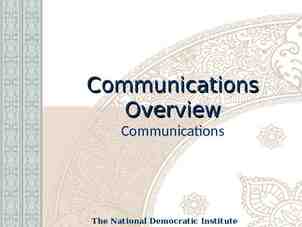The World After World War I: Nationalism and Revolution in
10 Slides2.56 MB
The World After World War I: Nationalism and Revolution in Imperialized Nations II. The Case of India The Movement to End British Rule Begins
What was the state of India after WWI? Britain promised gradual development of self-government in 1917 and reform are slow moving Britain’s attacks on Islamic Ottoman Empire have antagonized Indian Muslims Worldwide Influenza pandemic kills millions in India Mass-protests organized by Gandhi lead to massacre at the hands of the British
Most important political expression of an all-Indian identity: Indian National Congress (INC) Loyalists who wanted a more active role in the fate of India Largely moderate Largely urban phenomenon Bombay, Madras, Calcutta Largely high-caste English trained Hindus Lawyers, journalists, teachers, businessmen *country was multireligious w/ large populations of Muslims in certain regions Change traditional practices considered antiquated Spend money of development projects for economy Move towards self-government: Greater inclusion in political, military, and business life to better protect interests of Indians
How did the British respond? Slow calculated concessions Mocked INC’s claim to speak for ordinary Indians “divide and conquer” Played off minority Muslim fears that Hindu majority would seek to suppress their religion in an independent India Jailed radical leaders who called for terror and violence to achieve swaraj “independence” Above: General Reginald Dyer was responsible for ordering the attack in Amristar in 1919.
The key to unifying the movement was Mahatma Gandhi Satyagraha (“truth force”) South Africa Returned to India in 1914 and joined INC -quickly rose in ranks -periodic mass campaigns that drew wide, popular support (peasants, urban poor, intellectuals, artists, capitalists, socialists, Hindus, Muslims Non-violent noncooperation Simple, unpretentious lifestyle Representative of India’s poor Supported Muslims Wanted a united, cooperative India Sought moral transformation of individuals Indians and British Opposed a modern industrial future for India Wanted a society of harmonious, selfsufficient villages based upon ancient Indian principles of duty and morality
Amritsar Massacre, Spinning cloth and the Salt March 1919, Amritsar: BRUTAL massacre of gathering civilians by Gen Dyer. turning point of the mov’t Whole country responds to the massacre and the Crawling Decree Builds up Indian nationalism and selfreliance through resistance: Spin own cloth to undermine British textiles Attract international and internal media frenzy through the Salt March, 1930
Indian Independence Movement between WWI and WWII Divisions in Simultaneously INC because of methods, Unity goals, fears 1916: At Lucknow Session of INC, both moderates and extremist factions unanimously call for swaraj 1919: Amritsar Massacre takes place 3 days after nationalists hold a hartal (a day of fasting and prayer to protest Rowlatt Act, which drastically cuts civil liberties for Indians 1920: Civil disobedience campaign begins 1922: Gandhi arrested for sedition and spends 2 years in prison 1928: Residents in Bardoli district protest high rents using methods of non-cooperation 1930: Gandhi leads Salt March to sea; subsequently arrested for violating Salt Laws. Non-cooperation movements break out across India. Britain yields to protestors; releases prisoners 1931: Gandhi travels to London for Round Table Conference, returns to India and is arrested for sedition, held for 2 years without trial 1935: Gov’t of India Act passed, first movement towards independence 1939: World War II breaks out Disunity 1906: All-Indian Muslim League (AIML) founded and demands separate elections and fixed seats on local councils for Muslims 1916: Jinnah joins AIML 1920: Jinnah resigns from INC b/c he opposes policy of non-cooperation 1922: Nehru starts delivering speeches on how to deal with Hindu-Muslim unity, self-reliance, poverty, and employment 1931: Jinnah attends Round Table Conference in London 1934: Jinnah elected permanent president of AIML 1937: elections give INC control of many provincial gov’ts -these gov’t began enforcing teaching Hindu in schools, protect cows from slaughter -INC refuses to form a coalition administration w/ AIML in mixed areas. -relations btwn Hindus and Muslims begin to deteriorate
A secular, industrialized united nation working to end poverty, inequality and discriminations Above: Nerhu and Gandhi A united independent India of small traditional villagebased societies
(1940) We need a separate nation for Indian Muslims. I have major concerns about the INC’s plans. Above: Jinnah and Gandhi We cannot divide Indians. We must stay unified.
INDIA AND NON-ALIGNMENT















